The Islamic Museum of Art in Cairo is a leading global institution dedicated to Islamic heritage, housing over 100,000 artifacts from the 7th to the 19th century. Located in the Bab Al-Khalq district, the museum features treasures from Egypt, Iran, Andalusia, and more, covering fields such as calligraphy, astronomy, ceramics, manuscripts, textiles, and metalwork. Housed in a striking Neo-Mamluk building, the museum offers a deeply immersive experience, highlighting the artistic and intellectual achievements of Islamic civilization through centuries of cultural brilliance.
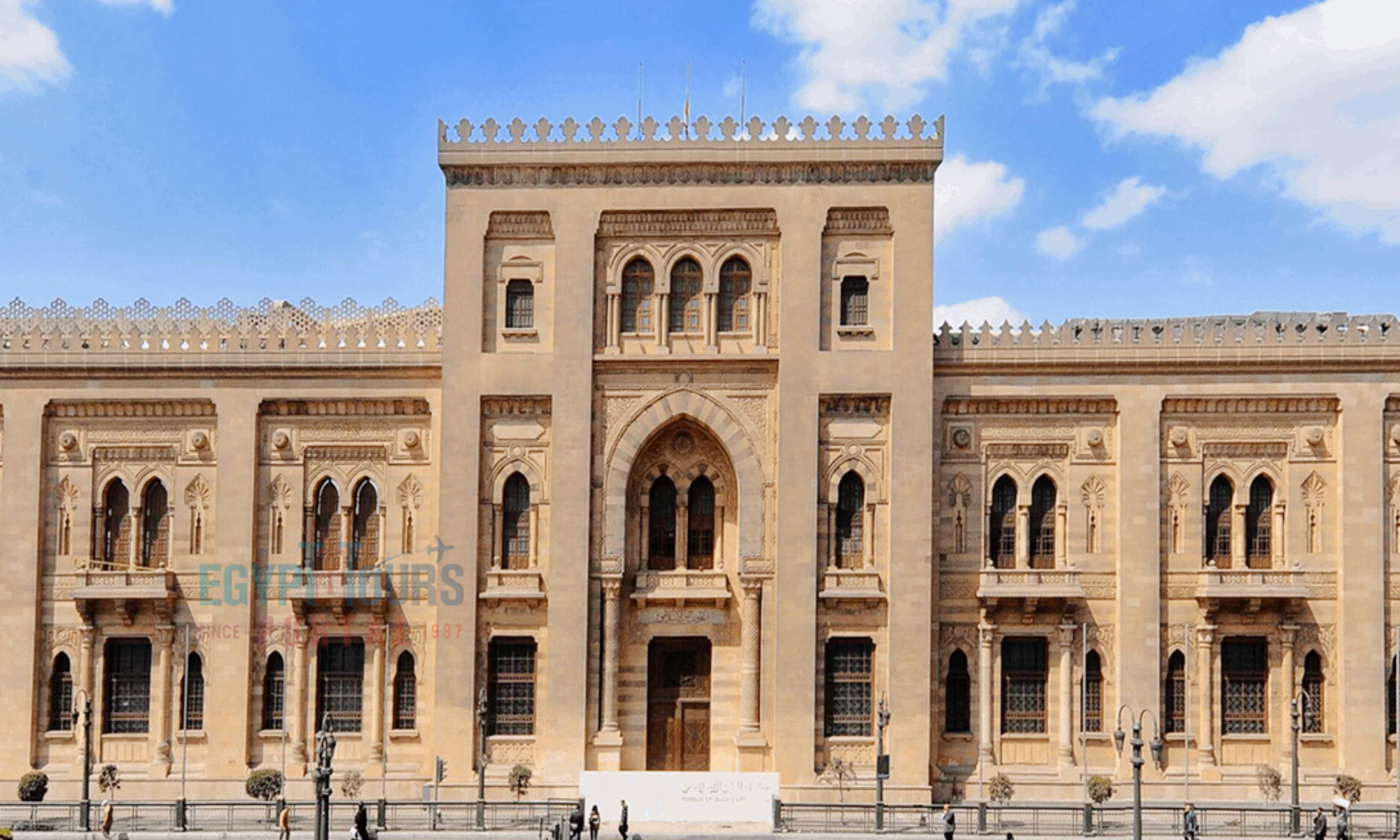
The Museum of Islamic Art in Cairo (MIA) is a cultural and artistic wonder that sheds light on the golden heritage of Islamic culture of Egypt that was cultivated in Egypt over 1400 years. It holds the ultimate coverage to shed light on the branches of Islamic Art across the ages, which in turn is the greatest beacon of Islamic civilization and art in existence. The museum offers a true passage across time that uncovers the rich skill and blessed imagination of the Islamic Egyptians who were able to craft some of the most beautiful and masterful collections of artifacts ever made.
It is by far one of the greatest Islamic museums on the face of the earth as it holds tens of thousands of artifacts that comes in great quality and quantity that provides the key to uncover the intricates of Islamic culture which are associated with Magnificat fields of Medicine, Horticulture, Surgery, architecture, and astronomy. It has many domains and halls that utilize a state of the art in interpretive technologies that offer the best experience of exploring the majesty and creativity of that golden time period.
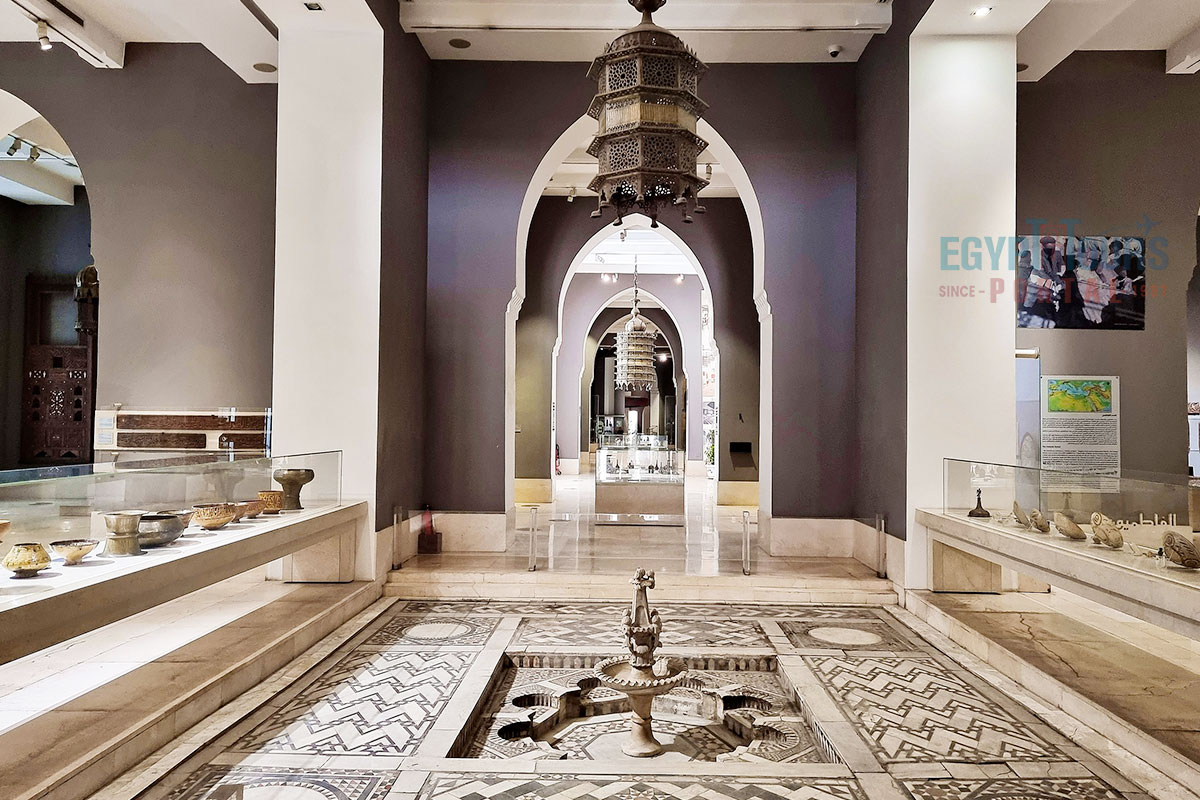
The Islamic Museum of Art is located in the historic district of Cairo, which is situated in the Bab Al-Khalq area, in the heart of Cairo's old city, with an address in Port Said Street, Ahmed Maher Pasha Square, Bab Al-Khalq, Cairo, Egypt.
Everyone can reach the Islamic Museum of Art through various means of transportation, located in the golden capital of Cairo. All can opt to take a taxi or a ride-sharing service to the museum. Alternatively, public buses and the Cairo Metro provide swift and safe accessibility to the area, with the closest metro station being Sadat Station, which is approximately a 15-minute walk from the museum.

The creation of Islamic Museum was created by Khedive Ismail Pasha, who established the Ministry of Endowments, which approved the construction in 1880 that building an Islamic art Museum in the massive courtyard of the mosque of Baibars. The head of the technical department at the Awqaf, the Austrian scholar of Hungarian descent “Julius Franz” transformed the ruined mosque of the fatimid caliph Al Hakim in 1881 that is found next to the Bab Al Futuh which acted as a temporary seat for the museum which held a furnished gallery in the eastern arcade that held 111 architectural pieces.
The Khedive Tawfiq approved the creation of the Arab antiquities who was responsible for running the Arab museum that provided and preserved the current museum with several Objects. Around 1884, a story structure was made in the courtyard, which was made to house a massive collection of 900 objects that had one staff od one person who acted as a doorkeeper and curator. Around 1887, an Austro-Hungarian scholar known as Maz Herz became known as the head of the technical department at the Awqaf, who made several important changes, including changing the name of the museum to the gallery of arab Antiquities.
Around 1895, the number of art collections increased to 1641 in the new building, which made it very crowded, so a new request was made to build a larger museum. Around 1899, the New museum’s foundations in Bab Al Khalq were added. The Islamic museum was designed by Alfonso Manescalo in Neo-Mamluk style in 1902, which holds an Upper story that houses the national library, which was demolished around 70s and underwent a process of renovation and redecoration. In the mid-80s, the Museum expanded by acquiring the neighboring land, which used to be a gas station.
They added two new halls for textiles, carpets, and storage. They also built a garden and cafeteria on the annexed land. In 2003, they underwent further development, constructing a three-story administrative building for staff, a library, a restoration department, and a lecture hall. The display layout was completely changed. By 2015, with the help of generous grants and donations from entities like the UAE, UNESCO, ARCE, Swiss Government, and Italian Government, the Museum was restored to its original state before an explosion.
Cast your eyes on the golden Islamic Landmarks of Egypt
Read More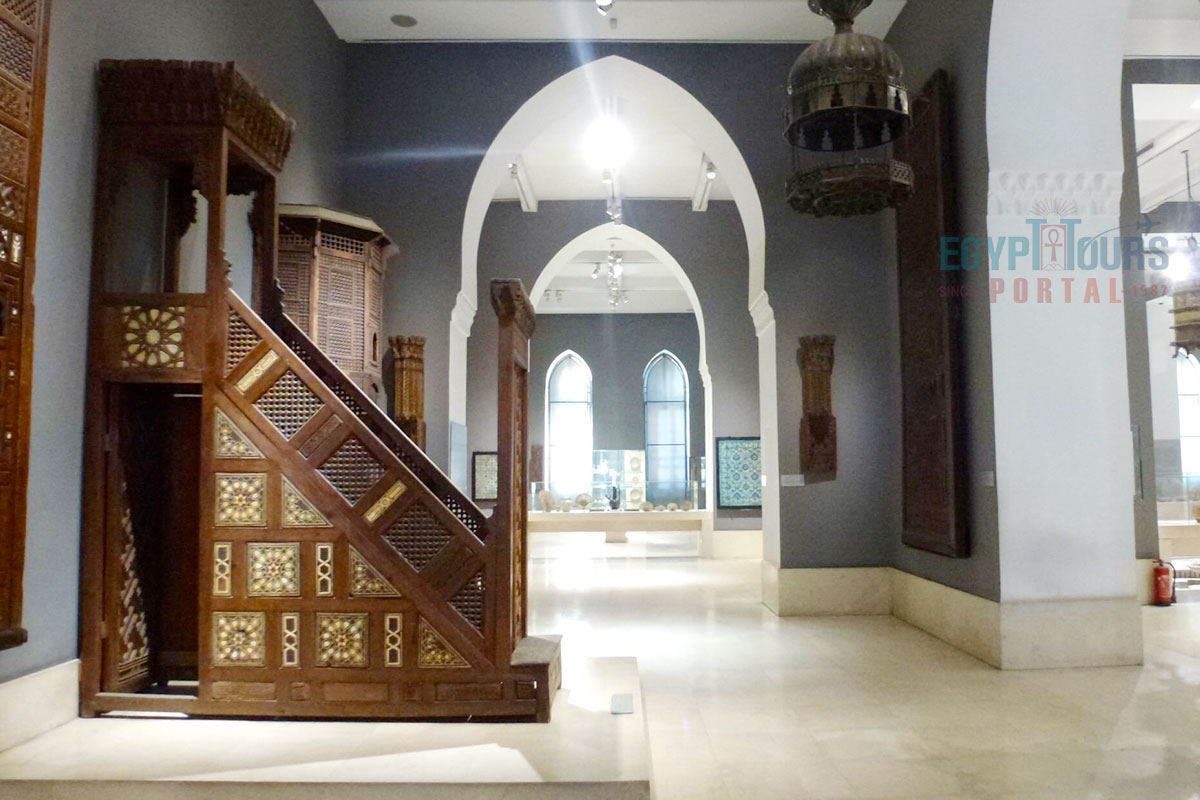
The architectural design of the museum was made of two entrances, where each is around the north-eastern & south-eastern sides. The building showcases a blend of neo-Mamluk and modern architectural styles, creating an elegant and impressive structure that complements the surrounding historic area of Cairo. The main facade features intricate Islamic geometric patterns and decorative elements. A beautiful garden was added that held a fountain that made its way to the first entrance of the museum.
The entrance that is found on Port Said Street featured a highly luxurious façade with magnificent decorations and several recesses, which was highly inspired by Islamic architecture from different time periods in Egypt. The two-storey building had a lower floor that contained a very large exhibition hall and an Upper floor that contained all the general stores.
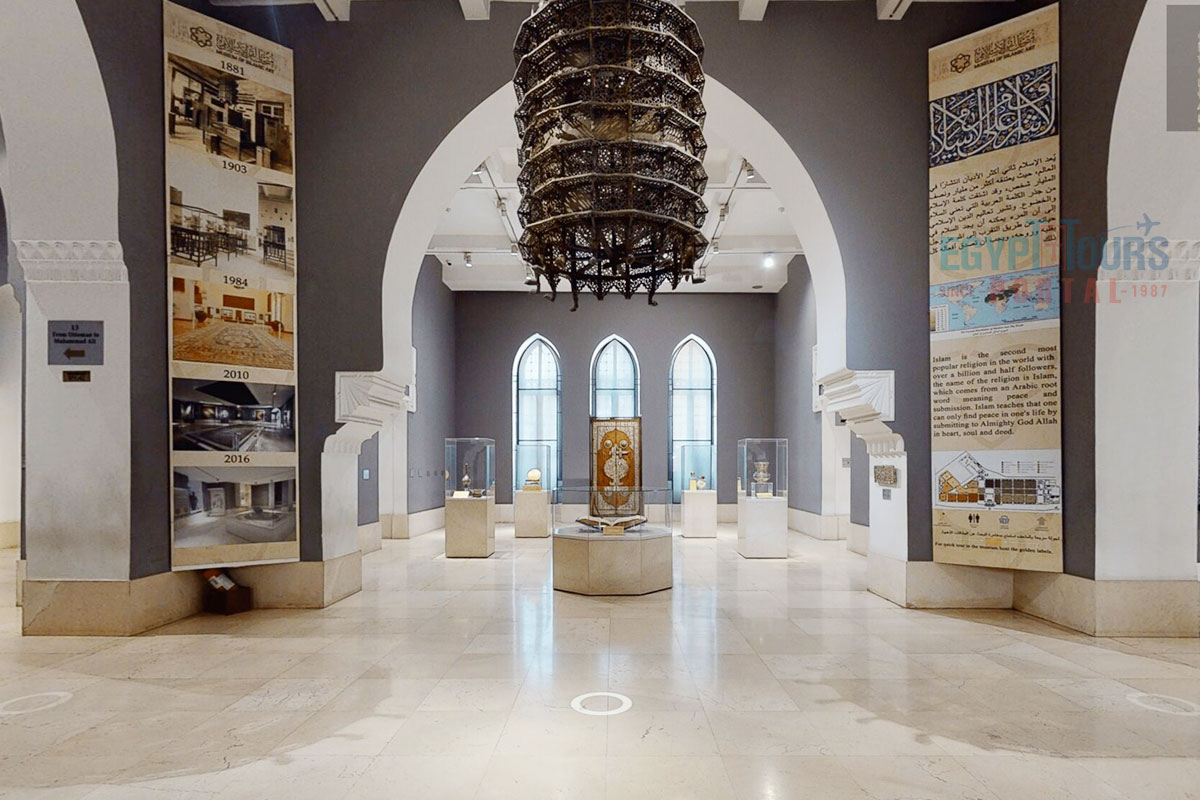
The Collections found in the museum are highly extraordinary and priceless as they come from different regions on earth, from Egypt, North Africa, the Arabian Peninsula, Andalusia, and Iran, ranging from the 7th to the 19th century. All the exhibited artifacts are found on the incredible right wing of the MIA, which is arranged according to their time periods, which are the Umayyad, Abbasid, Ayyubid, Mamluk, and Ottoman ages.
On the left wing of the MIA are several sections which are divided into sections of science, astronomy, calligraphy, coins, stones, and textiles, covering various epochs. A Mamluk key to the holy Ka’ba in Mecca and a golden textile bearing the oldest Kufic inscription are considered to be the museum’s most notable & beautiful possessions.
Some of the most famous collections include: The Islamic Calligraphy section holds a wide array of exquisite calligraphic works, displaying the artistry and beauty of Arabic script. The ceramics and Pottery sections are a diverse collection of ceramics and pottery, including decorative tiles, vases, and vessels, showcasing the mastery of Islamic potters. Metalwork sections are a captivating display of metalwork objects, such as intricately engraved brass and copper pieces, as well as splendid silverware.
The textiles section features ancient carpets, embroidered fabrics, and stunning textiles from different Islamic eras. The woodwork section has artistic wooden panels, screens, and furniture that exemplify the skill of Islamic woodworkers. Manuscripts and Miniatures are precious Islamic manuscripts and miniature paintings showcasing the literary and artistic achievements of the Islamic world.
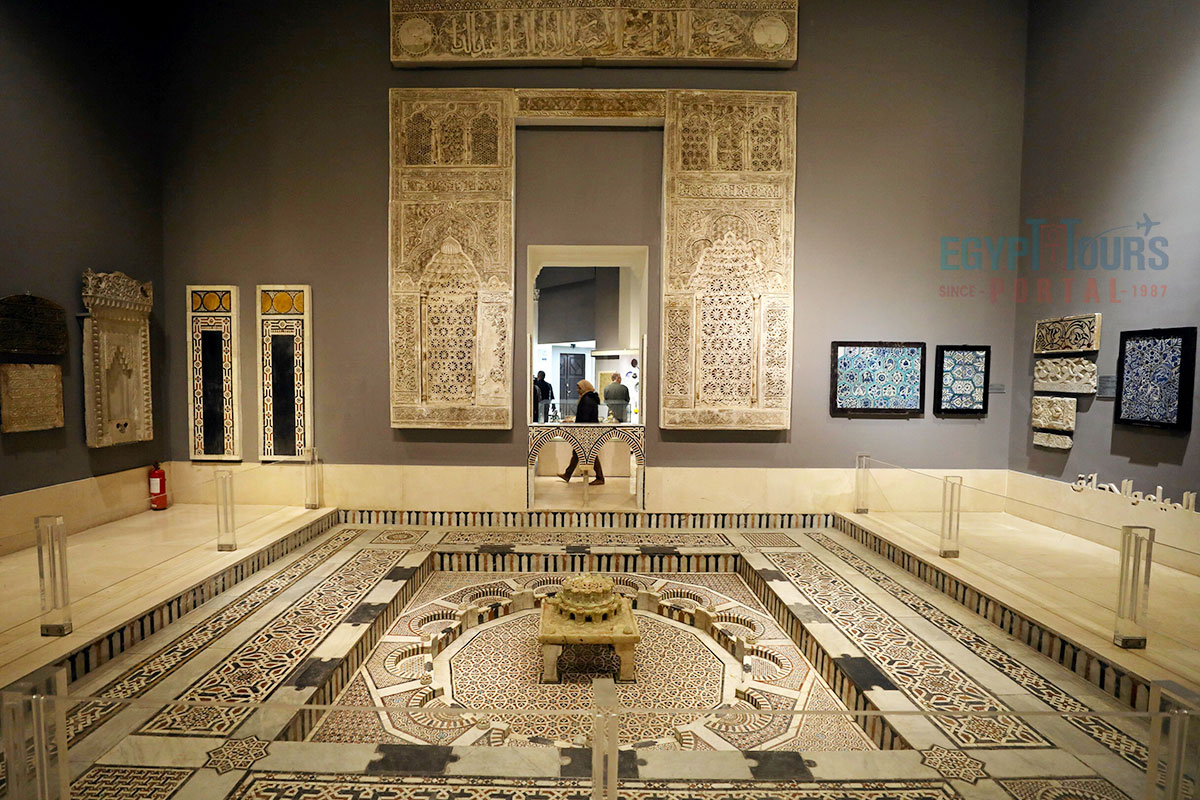
The phenomenal Islamic Museum of Art in Cairo is a cultural golden treasure that not only preserves the artistic heritage of the Islamic world but also offers everyone a miraculous journey through the rich history and diversity of Islamic civilization.
From its splendid architecture to its comprehensive collections, the museum provides an enriching experience for all those interested in Islamic art, history, and culture as everyone will get to appreciate the aesthetic beauty of the artifacts but also a chance to gain a deeper understanding of the significant contributions made by Islamic civilization to the world of art and culture. All our travelers from all over the world will have the chance to enjoy the most excellent and fun travel experience by being a part of one of our epic Egypt tours and boarding a marvelous Nile cruise.
Private 4 Days Cairo Tour Packages 4 days Cairo Egypt tour package will offer a bles...
Tour Location: Cairo – Giza...
Stunning 5 Days Cairo and Alexandria Tour Package 5 days Cairo and Alexandria tour p...
Tour Location: Cairo/Giza/Alexandria...
Exceptional 6 Days Cairo, Luxor & Aswan Tour Package 6 days Cairo, Luxor & A...
Tour Location: Cairo/Giza/Aswan/Luxor...
Amazing 7 Days Cairo and Hurghada Holiday 7 Days Cairo & Hurghada holiday will e...
Tour Location: Cairo – Giza – Hurgh...
The entire country of Egypt deserve to be explored with its every heavenly detail but there are places that must be seen before any other such as the breathtaking Hurghada's red sea, The wonders of Cairo the pyramids of Giza, the great sphinx, the Egyptian Museum, Khan El Khalili Bazaar, the wonders of Luxor like Valley of the Kings, Karnak & Hatshepsut temple and the wonders of Aswan such as Abu Simbel temples, Philea temple, Unfinished obelisk and The Wonders of Alexandria like Qaitbat Citadel, Pompey's Pillar and Alexandria Library. Read more about the best places to visit in Egypt.
If you want to apply for a Visa On Arrival that lasts for 30 days then you should be one of the eligible countries, have a valid passport with at least 6 months remaining and pay 25$ USD in cash, as for the E-Visa for 30 day you should have a valid passport for at least 8 months, complete the online application, pay the e-visa fee then print the e-visa to later be presented to the airport border guard. You could also be one of the lucky ones who can obtain a free visa for 90 days. Read more about Egypt travel visa.
Egypt has a variety of delicious cuisines but we recommend “Ful & Ta’meya (Fava Beans and Falafel)”, Mulukhiya, “Koshary”, a traditional Egyptian pasta dish, and Kebab & Kofta, the Egyptian traditional meat dish.
The best time to travel to Egypt is during the winter from September to April as the climate becomes a little tropical accompanied by a magical atmosphere of warm weather with a winter breeze. You will be notified in the week of your trip if the Climate is unsafe and if any changes have been made.
You should pack everything you could ever need in a small bag so you could move easily between your destinations.
We have been creating the finest vacations for more than 20 years around the most majestic destinations in Egypt. Our staff consists of the best operators, guides and drivers who dedicate all of their time & effort to make you have the perfect vacation. All of our tours are customized by Travel, Financial & Time consultants to fit your every possible need during your vacation. It doesn't go without saying that your safety and comfort are our main priority and all of our resources will be directed to provide the finest atmosphere until you return home.
You will feel safe in Egypt as the current atmosphere of the country is quite peaceful after the government took powerful measures like restructuring the entire tourist police to include all the important and tourist attractions in Egypt. Read more about is it safe to travel to Egypt.
Wear whatever feels right and comfortable. It is advised to wear something light and comfortable footwear like a closed-toe shoe to sustain the terrain of Egypt. Put on sun block during your time in Egypt in the summer to protect yourself from the sun.
The best activity is by far boarding a Nile Cruise between Luxor and Aswan or Vise Versa. Witness the beauty of Egypt from a hot balloon or a plane and try all the delicious Egyptian cuisines and drinks plus shopping in old Cairo. Explore the allure and wonders of the red sea in the magical city resorts of Egypt like Hurghada and many more by diving and snorkeling in the marine life or Hurghada. Behold the mesmerizing western desert by a safari trip under the heavenly Egyptian skies.
There are a lot of public holidays in Egypt too many to count either religious or nation, the most important festivals are the holy month of Ramadan which ends with Eid Al Fitr, Christmas and new years eve. Read more about festivals & publich holidays in Egypt.
Egypt is considered to be one of the most liberal Islamic countries but it has become a little bit conservative in the last couple of decades so it is advised to avoid showing your chest, shoulders or legs below the knees.
Arabic is the official language and Most Egyptians, who live in the cities, speak or understand English or at least some English words or phrases. Fewer Egyptians can speak French, Italian, Spanish, and German. Professional tour guides, who work in the tourism sector, are equipped to handle visitors who cannot speak Arabic and they will speak enough English and other languages to fulfill the needs of all our clients.
The fastest way is a car, of course, a taxi. If you are in Cairo ride a white taxi to move faster or you could board the fastest way of transportation in Egypt metro if the roads are in rush hour.
The temperature in Egypt ranges from 37c to 14 c. Summer in Egypt is somehow hot but sometimes it becomes cold at night and winter is cool and mild. The average of low temperatures vary from 9.5 °C in the wintertime to 23 °C in the summertime and the average high temperatures vary from 17 °C in the wintertime to 32 °C in the summertime. The temperature is moderate all along the coasts.
It is the home of everything a traveler might be looking for from amazing historical sites dating to more than 4000 years to enchanting city resorts & beaches. You will live the vacation you deserve as Egypt has everything you could possibly imagine.









